#kristy wilson-cairns
Text
1917: Brotherhood in a War-zone
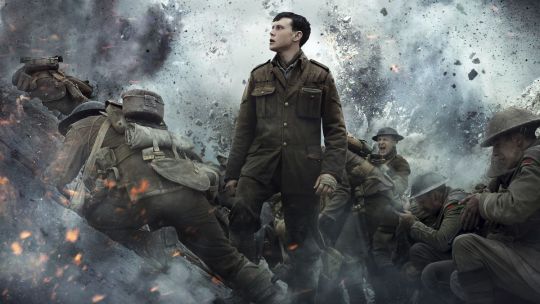
If you have not seen 1917 you should know there are major spoilers ahead. You should also know that you are missing out on what can only be assumed as the best film of the century thus far. Go watch it. Seriously, go.
For those who saw my post a few days ago I finally got around to watching the phenomenal Sam Mendes war film 1917 starring George MacKay and Dean Charles-Chapman. Sprinkled throughout the film are also an ensemble cast of supporting actors such as Benedict Cumberbatch, Andrew Scott, Mark Strong, Richard Madden and Colin Firth. And if you saw that post you’ve seen how I was justifiably blown away by how extraordinary the film was. Since then I have watched it several more times, yes several back-to-back viewings in which I took notes, picked out things I missed the first few times and essentially got swept away with each watch. I have also watched interviews with the cast and crew and read the script online. I cannot emphasize enough how much I love this film. But I will give it a go in the following analysis of what this film meant to me, and what Sam Mendes was clearly striving to convey to audiences. Fair warning, this is gonna be a long one.
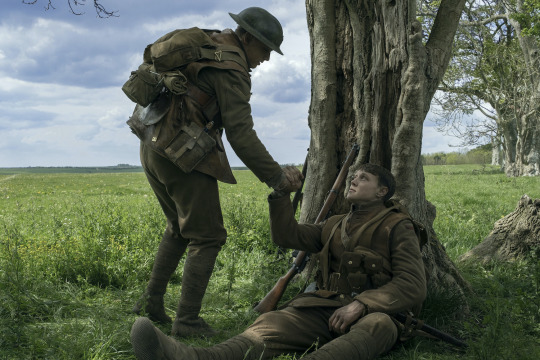
At the beginning of the film we start off in a quiet, beautiful meadow untouched by war. Flowers swaying in a gentle breeze, clouds overcasting the scene below, and the seemingly “one-shot” begins. An interesting way for a film about World War I, or “The Great War” as some called it, to kick off. However, this start becomes important in comparison to the ending which we will examine more closely later. The thing to note for now is the peace of the present atmosphere, and the two soldiers we find napping beneath a tree.
These soldiers are Lance Corporals Thomas Blake and William Schofield. Blake is soon summoned by his Sergeant and told to “pick a man”. On my initial viewing of this film I at first thought that Blake chose Schofield due to his proximity to him. Throughout the film it’s clear they know each other and have for some time, but it wasn’t until I read the script and saw the movie a few extra times that I realized Blake and Schofield are proper friends, brothers even, and that their friendship is vital to the overall story being told. In an interview, Sam Mendes mentioned that Blake was “the heart of the film”, and in the script it actually says, when Schofield is carrying Blake’s lifeless corpse, that “nothing is heavier than the body of someone you loved”. So though we are only seeing a small fragment of time between these two friends we can see that they have a history and a bond that will deepen in the course of this story.

The first glimpse at this bond comes from the beginning. Blake asks Schofield if they were fed today, and Schofield replies that they only got mail from home as he precedes to hand Blake a letter. Blake reads the letter and comments wistfully “Myrtle’s having puppies” to which Schofield smiles. This small interaction tells us that Blake was not around when that day’s shipment came in, possibly he was already napping by the tree. It tells us that Schofield was there and was either handed, or offered to take, Blake’s mail. It’s clear that wherever Blake had been during the shipment he still ended up napping under that tree before Schofield, as Schofield chose to keep the letter on him to give to Blake later, presumably so as not to interrupt his friend’s sleep. The other thing we can assume is that this is not the first time Schofield has heard about Myrtle. There’s a familiarity in the way Blake mentions “Myrtle’s having puppies”, and not “my dog is having puppies”. Sure we can easily assume who Myrtle is as can Schofield, but the offhand, familiar way he tells Schofield this bit of news implies that Blake has probably talked about his dog before. Also the fact that neither asks about each other’s families also implicates that they may have already spoken or asked about these things. Mostly I see Blake being the one asking about and volunteering information on family as Schofield offers small, un-detailed glimpses of his home. But all in all the interaction gives us enough information to show us that these two soldiers are already friends, which adds a level of sweetness to when Schofield shares half of his ham and bread with Blake.
After our introduction into the relationship of these soldiers we are next taken into a dugout where we meet Colin Firth’s General Erinmore. It is here that we find out the plot of the story. Blake and Schofield, one by summons and the other by chance, are commanded to carry a message through “No Man’s Land” across enemy territory. The message: the Germans have withdrawn from their present occupation and have formed a new, much more fortified line (known in history as the Hindenburg line), essentially setting a trap for the 2nd Devons which are prepared to give chase. The 2nd Devons, whose leaders were unaware of this strategic move on the German’s part, consisted of around 1,600 men. One of those men included Lt. Joseph Blake, older brother of Thomas Blake.
So our characters now have their mission and for Blake in particular there is a deep personal connection. For both the stakes are high. Blake knows that if they fail their mission there is certain death for his brother and 1,600 men. Schofield knows that if they undertake this mission there is almost certain death for either one or both of them. As they begin their journey to the front up the down trench we begin to get a picture of how these two men differ from one another. Blake, moved by his brother’s life in the balance, takes off without another thought while Schofield desperately tries to reason that they need to take the time to plan out what they are going to do. Schofield is in favor of waiting till dark in order to give Blake and himself the best fighting chance against being spotted while Blake wants to set out immediately in order to reach his brother with time to spare. It’s clear Blake is the emotional one while Schofield the rational of the pair.
Each man’s view on the matter is understandable. Anyone in Blake’s position would want to save someone they loved, and being younger, more emotional, and more reckless with far less experience in the war, he is not inclined to hear Schofield out. Schofield on the other hand has some experience as we learn when Blake asks about his time at the Battles of Somme, and comments on how Schofield earned a medal from his actions at the Battle of Theipval Ridge. Schofield replies that he doesn’t remember much from the battle and that he no longer has his medal. From what we can tell in this exchange Schofield is not willing to talk about whatever it was he experienced at Somme and there may be a ring of truth when he says he doesn’t remember much. Schofield as we’ll come to see throughout the film has a tendency to separate and compartmentalize everything from his emotions to his family to his combat history. This is important to know about him now because this journey is going to break those compartment walls down until their contents begin to bleed into one another.

We next meet Andrew Scott’s brilliant take on Lt. Leslie, a brash, dry military leader on the front lines who has clearly seen too much. His character serves as a cold and pessimistic voicing of the dangers that face our protagonists and through Leslie we begin to see the toll of what this war has done to these men. It’s honestly one of my favorite scenes and Scott is probably my favorite supporting cast member followed closely by Richard Madden as Joseph Blake. And with Leslie’s harsh “you’re probably going to die” attitude sending them off, Schofield and Blake enter No Man’s land.
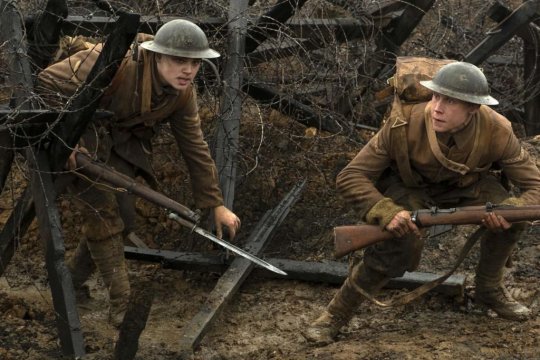
One of the truly astounding accomplishments of 1917 is how they pull the viewer into this journey with Blake and Schofield. The “one-take” shot and close-ups to the characters and what they are seeing make you feel as if you are traveling with them, and the set and prop designers don’t hold back. We are treated to a version of No Man’s land in which you can actually imagine how horrible the stench must have been. From carcasses of both horses and men rotting in the mud to flies and rats feasting on the remains to puddles littered with debris and the dead. The land is scarred with craters and mazes of twisted barbed wire, and not a single living thing can be seen aside from our two soldiers. Not to mention that the fumes of the mustard gas commonly used during this war must be clinging to everything. A stark contrast to the start of the film. Thomas Newman masterfully scores the scene with a haunting, almost dreadful, melody that builds in intensity until you’re certain some danger awaits Blake and Schofield. But they’ve made it to the German front lines and not a single enemy remains behind, and thus we enter the German dugout where, as we know, Schofield and Blake will come to realize the Germans did not leave without setting a few traps for whoever might follow.
It’s here in the dugout where we begin to see how close these two really are, at least for Blake. After the rat sets off the tripwire an explosion rings out causing a partial collapse of the dugout on Schofield. Fortunately, Blake was only blown back and quickly recovered in order to follow Schofield’s muffled screaming and begin digging him out. Chapman portrayed Blake’s desperation remarkably well. In an interview when asked how it was to take direction from Mendes, Chapman mentioned this scene and how Mendes had taken him aside and said to him, “Dead. You’re best friend could be dead”. Therefore, Chapman played the scene accordingly with Blake frantically digging and calling for his friend, sobbing out his name when he finds him seemingly lifeless, and desperately yanking Schofield to consciousness and to his feet.
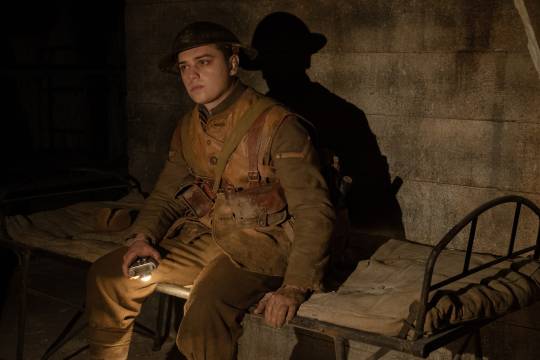
The scene is an intense, edge-of-your-seat, hold-your-breath ride for survival as the two race for an exit with Blake leading a blind Schofield to safety. Not once does Blake think of leaving his comrade behind, and considering his desperation to save his brother you’d think the thought would have crossed his mind, but it doesn’t seem to in the least. Either they both make it out or they both die. Schofield’s reaction to his near-death experience is also important for now and for later. This is Schofield’s first, and certainly not the last, brush with death on this particular mission and it is the one that would have definitely killed him off if not for Blake. However, his initial knee-jerk reaction is one of desperate irritation. He tells Blake off for choosing him for this mission, despite knowing full well Blake had no idea what they were getting into. He then pulls out a thin, tin can and briefly peers at the contents before slipping it back into his pocket. As we know by the end of the film, inside that tin can are photos of his wife and daughters. After rinsing his eyes clear of the blinding dust the first thing that Schofield chooses to look at is his family. And here is the first sign of the impact this mission will have on those compartments that Schofield keeps separated. His near-death experience breaks through that first wall enough to get him to take another glance at what he almost lost.
I want to point out that despite his initial annoyance at Blake it’s made evident that Schofield is in fact very grateful to his comrade. I find it interesting and refreshing that he doesn’t apologize for his outburst or indicate that he knows Blake never meant to drag him along on a dangerous mission. Instead, he does something even better that points to how well he knows Blake, how much he cares for him, and something that will ensure Blake knows how grateful he truly is. I’m talking of course about the “bit of blood tin” scene. Schofield assures Blake that he will get a medal for his actions in the dugout and for saving his life. This implies that Schofield not only believes Blake has earned the honor but that he himself will make sure others hear of it if he survive’s the mission. The conversation also gives us a deeper insight into Schofield. He knows the medal would mean a great deal to Blake which is why he mentions it, but simultaneously his attitude suggests that he himself doesn’t care for such honors. When pressed by Blake we learn that he even traded his own for a bottle of wine. We never learn what it is Schofield did to earn the medal but it’s clear that whatever it is it carries painful memories in which he feels no honor in. We also learn why he told Blake earlier “it’s better” not to return home on leave. Schofield states he “hated” going home because the pain of knowing he would have to leave and his family may never see him again nor he them was too great. For someone who so desperately tries to compartmentalize his family from the war returning home only to be sent back would make that struggle all the more difficult, which is why he can only briefly look at his family’s photos.
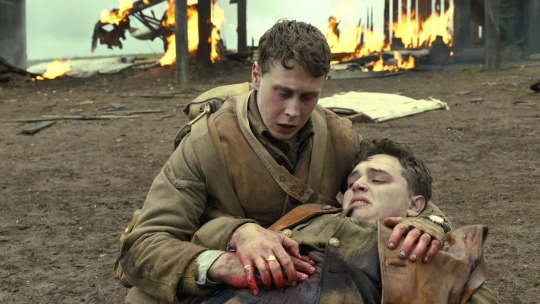
Unfortunately, we soon reach what is the most pivotal scene in the film and in Schofield’s journey. Blake’s death. I believe that this scene while not the climax of the movie is the true beginning of Schofield’s “change of heart”. Earlier I mentioned how Mendes had once called Blake the “heart of the film”, and in another interview co-writer Kristy Wilson-Cairns broke down the ending scene of the film and stated that during his mission Schofield “takes on Blake” and that “Blake becomes a part of him” by the ending because of the promise he makes as Blake dies. So Schofield’s change of heart is that his heart becomes a bit more like Blake. It’s not a story of supernatural possession, nothing as silly as that, but rather a story of friendship and humanity that changes how Schofield perceives the war, himself, and the value of human life. Remember that leading up to Blake’s death Schofield was ready to kill the German pilot, saying “we should put him out of his misery”. But Blake held to compassion and refused to kill him which tragically resulted in his death. As Schofield carries on with the mission he is left with the hopes of his dead friend who died because of his goodness, and as he continues on we also see an increasing unwillingness to kill his enemies. Also important to note is that Schofield knows full well that Blake saved his life yet as Blake died there was nothing he could do making the promise to finish the mission and save Blake’s brother all the more vital.
Shortly after Blake’s death we meet Captain Smith played by Mark Strong. Like every character we meet along the way Smith plays a vital role in Schofield’s journey. Through Smith we learn that delivering the message may not be as simple as handing over the envelope. Schofield will have to fight to make sure it’s actually read. We also learn how quickly these young men were expected to adapt and move on when faced with death and loss. Strong played the role very well as he gave Smith a commanding sense of kindliness, wisdom and understanding. You get the sense that here is a Captain that understands the strength of brotherhood in wartime and has seen that look of a soldier who’s lost his brother. And so for the first time we see a commander who is gentle in his manner to Schofield but firm enough to get him back on his feet and moving. He then suggests to Schofield that it’s “better not to dwell on it” and though Schofield acknowledges him it’s obvious that as he bumps down the road in the back of a wagon packed with young soldiers telling jokes and oblivious to what he’s just gone through, Schofield can think of nothing but Blake.
MacKay acts his heart out in this scene and he doesn’t say a word or do anything, but the veiled pain is there, the furrowed brow is there, the look of a young man haunted by grief is there, the way he looks back out over the grounds where his fallen brother lies is there. His silence and disinterest in the soldiers and their jokes shows that Schofield is undergoing a quiet, grieving process of which will have changed him by time he climbs out of that wagon. When the wagon got stuck in the mud and Schofield begged for the others to help we begin to see a little of Blake in him. At the start of the mission Blake was desperate, emotional and unwilling to wait around to plan things out rationally. Now we see Schofield desperate, emotional, and unwilling to wait around to get the wagon out an easier way.
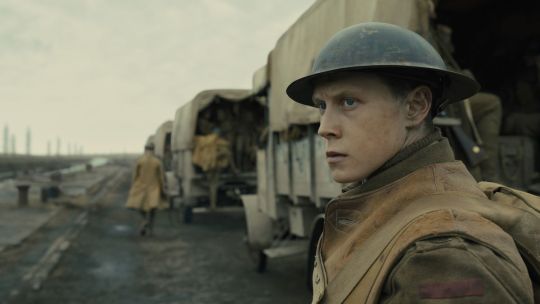
The next scene was similar in nature to that of the tripwire scene with the nerve-wracking intensity of a life-or-death situation except now Schofield is solely on his own. He manages to maintain a level-head and provide cover fire for himself, true Schofield-style and proves to be an excellent shot. However, he manages to get himself knocked out so that by time he awakes he is low on time and is now faced with enemies on all sides. The scene of the night window is one of the most beautiful works of cinematography I have ever seen. I get chills every time. With Newman’s astounding score and MacKay’s sense of wonderment the scene feels otherworldly, and before long Schofield is running for his life through the ruins of the city and coming across a burning church making you feel as if he has awoken in the pits of hell. But the ever rational Schofield quickly seeks shelter in a basement of what appears, at first glance, to be an abandoned building. Soon Schofield finds that in fact the basement is occupied by a young, frightened French woman and a baby girl. This is one of the few moments in the film in which Schofield gets an opportunity to catch his breath and take a break of sorts from the war. The woman tenderly cleans his head wound and Schofield gives literally every last bit of food and milk he has to the woman and the baby. Despite yet not knowing what waits for Schofield back home, or rather who waits for him, the viewer gets the sense that Schofield is no stranger to children and babies. He quietly recites a bit of poetry to the baby girl from Edward Lear’s “The Jumblies” and we even see a small smile from Schofield as he interacts with the child.
However, Schofield hears the tolling of the church bell and realizes he’s out of time and quickly makes his departure back to the war above, despite the woman’s pleas. The scene with the woman and child were important for Schofield’s journey because of the significance they held to him, particularly the baby. The likelihood that the pair will survive the war is not high and even if they do that baby is most likely never going to know who her parents were. Schofield purposefully chooses to separate his children from the war in his mind but now he has been forced to see the face of a child who’s entire life and existence has been uprooted and changed by the war. After making a desperate flee through the city and into the depths of the river Schofield crawls onto the shore of Croisilles Wood having to climb across the dead to do so. Literally stripped down, with just the uniform on his back, the exhausted, wounded and fearful soldier is overwhelmed by his grief and he sobs, as the script says, “for the river, for life, for Blake, for the baby”. By this point Schofield has nearly died multiple times, lost his brother-in-arms, been forced to abandon a young woman and baby, and fears he may be too late to fulfill his promise to Blake meaning that 1,600 men could already be dead. Very understandably, it’s just a little too much for even Schofield.
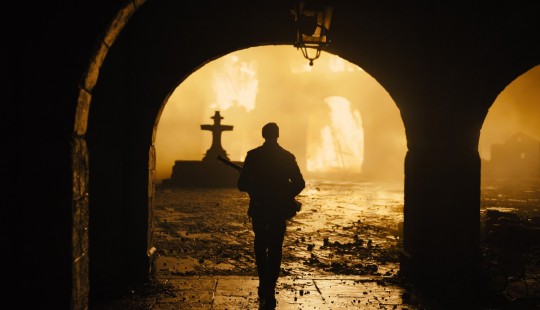
We then get treated to one of the most beautiful and haunting scenes of the film. The Wayfaring Stranger scene, in which a soldier sings a beautiful hymn, and the camera circles around the faces of young men who are just barely out of boyhood, shows us the nature of what Schofield’s mission is meant for. These are the men he needs to save. Poor Schofield is on the verge of giving up, but when he’s told that he’s where he needs to be he manages to climb back to his feet and keep moving. This chokes me up every time on a personal level, because while I could never know what it is to keep moving forward in a war zone, I know how it feels to be physically exhausted to the point of wanting to collapse in my time as a firefighter. But you have to put yourself aside, you have to forget whatever pain your mind tells you you have, and you focus on the mission at hand and you never stop moving and you never give up. That requires a mental strength that comes through months of training and which Schofield demonstrates in that moment. His race through the 1,600 men and his pleas for the commanders not to send their men over gives the film’s climax the perfect build-up. I was very glad to have not seen the trailer beforehand, so I was not waiting for “that running scene”. When he stopped and looked up at the edge of the trench I remember thinking, “oh my god he’s not about to do what I know’s about he to do!” and sure enough Schofield climbed once again into No Man’s land, this time knowing without any doubt that Germans were on the other side with all their weapons trained at him. This version of No Man’s land is a fantastic parallel to the No Man’s land he crossed earlier with Blake. The green grassy field remains untouched by the war thus far and the soldiers on the field are living, breathing men rather than rotting carcasses. So Schofield runs parallel to the trench as the men run straight to the enemies line unaware that this lone man is risking everything in order to save them from the fate he and Blake witnessed when they first set out on this mission.
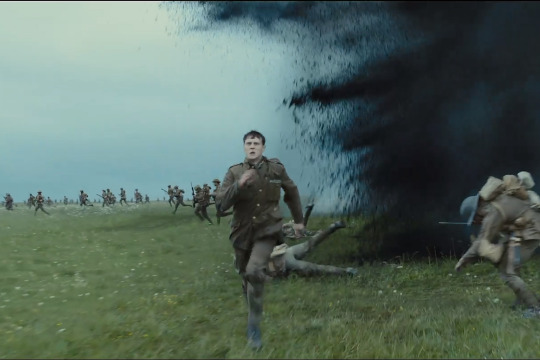
True to Smith’s warning Schofield had to fight for the Army command to be read. Benedict Cumberbatch portrayed Colonel Mackenzie, a harsh, no-nonsense military strategist who is utterly tired of the game and ready to end the war. Fortunately, Schofield says just the right thing to catch Mackenzie’s attention and effectively stop the battle. He couldn’t save everyone but he prevented what would have been an outright massacre. And so that leads us to the last leg of his mission, the one he didn’t set out for when he and Blake left Erinmore’s dugout but which fell to him nonetheless. Striding through the casualty tents Schofield unfortunately has to bear witness to those who could not be saved despite his best efforts and he finds himself near Lt. Blake, whom he recognizes by voice alone. Madden offered one of my favorite performances as the brother Lance Corporal Blake was so desperate to save. His joy at the prospect of seeing his little brother turned to shattered disbelief and sorrow at realizing he has lost his brother. The scene is quiet and still and powerful in that stillness, and yet somehow there’s a sense of hope as Schofield tells him that Blake saved his life. A sense that Blake’s kindness and bravery lives on in his brother and in Schofield. So when Mendes said that Blake was the “heart of the film” he’s essentially saying that the heart of 1917 are the countless lives lost during that Great War, because the character of Blake serves as representation of every young soldier who never made it home, who never got the chance to live out their lives or build a family or see their loved ones again. But Mendes wanted this film to act as a tribute to those stories, and though Schofield was not designed to portray Alfred Mendes (the director’s grandfather who in fact served as a messenger during WW1) he does represent those soldiers who survived and were able to tell the stories of those who did not.
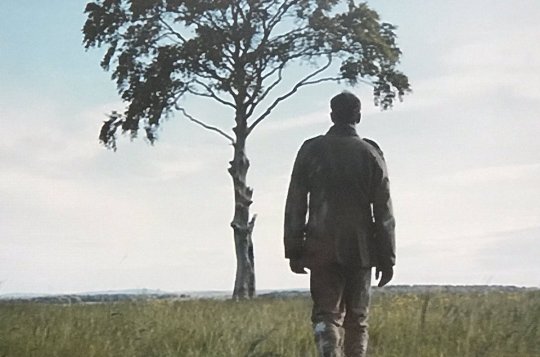
Now whether or not Schofield will survive till the end of the war is unclear and not really the point of the story (I personally like to think he did despite the probable infection he’s likely to have in that hand of his). However, his completion of his mission and his passing of Blake’s mementos to his brother and his promise to write their mother about Blake’s heroics shows that he intends to make sure that Blake’s honor lives on. Then, we see Schofield do what he could not do before the start of this mission. He pulls out the photos of his family and gazes into their faces, reading the message written by his wife, “Come back to us”. He leans his head back against the lone tree and closes his eyes for what I’m sure is a much needed nap. To his right spreads a peaceful, open field just like the movie’s introduction except this time Blake is only with him in memory and in heart.
Bless you if you’ve read all of this and thank you! Once again I cannot express how much I love this film. It appeals to everything I love the most from art to history to humanity and the complexities of the human mind to feats of heroism to struggles of man. It’s beautiful, it’s devastating, it’s unforgettable. If you are fan of the movie as well please let me know what you loved most! Also feel free to comment on the analysis or add your insights!
#1917#sam mendes#kristy wilson-cairns#george mackay#dean charles chapman#benedict cumberbatch#richard madden#colin firth#andrew scott#mark strong#william schofield#thomas blake#films#history#ww1#cinematography
127 notes
·
View notes
Text
2019 BEST PICTURE NOMINEE: 1917
So begins another year reviewing the best picture nominees and we are off to a strong start.
Kudos to the movie’s trailer, which did an excellent job of selling the movie with a tense ticking clock sound combined with the image of an unarmed soldier running alone in a battlefield while other soldiers run a different direction. And 1917 lives up on the trailer; going beyond the stiffness associated with World War 1 to bring us a gripping experience.
General Erinmore (Colin Firth) sends young Lance Corporal Blake (Dean-Charles Chapman) on a mission; deliver a message to Colonel Mackenzie (Benedict Cumberbatch) of the Second Battalion of the Devonshire Regiment calling off an attack on a German battalion. Mackenzie believes he’s got the “Huns” on the run but, the German army is leading him and his soldiers into an fatal ambush. Being the best at maps, it is up to Blake and fellow Lance Corporal Schofield (George Mackay) to deliver the message by tomorrow or thousands of British Soldiers will be killed, including Blake’s older brother (Richard Madden).
The camera follows Blake and Schofield through their journey as they trail across destroyed farms and abandoned trenches, racing against time to prevent the deaths of their allies. Through the journey you are on the edge of your seat because you know there could by a sniper or a booby trap around every corner. Even the sound of distant airplanes could spell danger.
From the opening image of Black and Schofield resting on an empty field, Director Sam Mendes and Cinematographer Roger Deakins showcases both the beauty and ugliness of Blake and Schofield’s circumstances. As they walk across battlefields, we bear witness to the ugly devastation of decaying horses on the ground, dead rats hanging in tunnels and bloated dead bodies floating in puddles. And yet there is also the beauty of cherry blossoms and a soldier singing to his resting allies. There are even moments of beauty and ugliness clashing when a flare lights up the night to reveal the ruins of a war-torn village.
Just as engaging are the performances. While the film has a few big named actors, the real stars are Chapman and Mackay. They bounce off each other with ease, with Schofield trying to get Blake to think before acting while Blake forges ahead, determined to save his brother. But it’s Mackay who truly stands out, with Schofield going from being understandably cautious after the last encounter with German soldiers to a brave hero.
It seems that World War 1 is having its time in the cinematic spotlight, with the most recent standouts being Peter Jackson’s documentary We Shall Not Grow Old and the superhero hit Wonder Woman. But very few capture the claustrophobic, tense feeling of walking through a battlefield that 1917 does. And since winning the Golden Globe for Best Picture-Drama, it has become the underdog that could take home the trophy. Though you could argue it is also a safe choice compared to the bolder contenders nominated in the same category.
#Oscars#2020#academy awards#academy award nominee#1917#sam mendes#world war 1#the great war#dean charles chapman#George mackay#colin firth#benedict cumberbatch#richard madden#kristy wilson cairns#thomas newman#best picture#best director#best original screenplay#best makeup#best production design#best score#best sound mixing#best sound editing
7 notes
·
View notes
Text
LAST NIGHT IN SOHO Delivers Everything You’d Want from an Edgar Wright Horror Movie, While Also Being So Much More

I wasn’t sure if I was going to write a review for Last Night in Soho, at least not a full one, because I had already assigned the Below the Line review to another writer, the brilliant J. Don Birnam, and I thought JDB would do a good job reviewing it without the expectations or personal bias I might have, having known director Edgar Wright for a very long time.
But it turns out that after I saw Last Night in Soho, I felt that I had too much to say for just a mini review in next week’s column, and I wanted to marvel at the amazing craft but didn’t want to take away from what my pal JDB might write.
What do you know about Last Night in Soho? Maybe you’ve watched the trailers and think you know a lot. Hopefully you didn’t read any reviews that might spoil the many twists, because this is one of those movies where you can get lots of joy from being surprised, and yes, quite shocked.

The Cliff notes plot is that it stars Thomasin McKenzie (Jojo Rabbit) as Eloise “Ellie” Turner, an ambitious young woman enthusiastic about moving from her Gran’s house in the boonies to London to go to school for fashion. Like many young people going to college in a new place, Ellie isn’t particularly confident, and she has difficultly making new friends among a group of catty, partying fashion types, including her awful roommate, Jocasta (a very funny Synnove Karlsen). Not fitting in with these “Mean Girls,” Ellie moves to a bedsit in the house of a rather strict landlady (the late, great Dame Diana Rigg in her final role) which is just fine with Ellie’s lifestyle, though once there, she also starts experiencing odd occurrences. Elllie has this knack for seeing ghosts, but she has begun to a woman from ‘60s Soho named Sandie (Anya Taylor Joy), who is trying to be a club singer -- in fact, Ellie starts watching Sandie’s life as it plays out, once she meets an amorous manager, played by Mat Smith, and Sandie becomes a muse for Ellie’s fashion designs, until things start going bad for Sandie.
First and foremost, Last Night in Soho is a story about ghosts (vs. a ghost story) as well as a murder-mystery. It isn’t necessarily gothic horror or Giallo, as some might be expecting, but those influences are in there, as are others. Unlike his fellow filmmaking pal Tarantino, Wright always seems to be able to integrate and hide his influences by burying them in a story original enough that you don’t immediately go, “Oh, this is him doing this” or “This is him doing that.” Sure, there is something underlying that will make you think of other movies, but unless you’re a human IMDb (which I am most definitely not), you’re gonna have trouble putting your finger on it.

Much of the fun of the film comes from how the story builds to make you wonder what Ellie is seeing and experiencing. Are these dreams? The supernatural? Real events fro the past? It offers enough of a big-time mind-fuck -- something I quite enjoy actually -- that you’re never sure whether what she’s seeing is in her own mind or whether maybe you’re going a little crazy yourself. That feeling only increases as the film goes on.
What truly sets Last Night in Soho apart from Wright’s previous films is that it’s his first movie told completely from a female perspective. Of course, he’s had fabulous and important women characters around his male protagonists in all his previous movies -- Ramona in Scott Pilgrim, Debora in Baby Driver, etc. -- but this one really stands out due to three very important women collaborators, the two main actresses, and also co-writer Kristy Wilson-Cairns, whose previous script was for the Sam Mendes war movie, 1917, a movie with all men, oddly enough.
I can’t stress enough how great Thomasin McKenzie is as Ellie, because after Leave No Trace, it’s probably the young actresses’ most significant role and one that gives her so much to experience and show off what she can do. It’s maybe the first time that I’ve really been pulled into a movie by her character and performance, since Ellie is written so well. Anyone who has seen Anya Taylor-Joy in anything knows how fantastic she is at what she does, but Sandie is another particularly juicy role for her, one that goes through just as much of a transformative character arc as that of Ellie, and similarly, still leaves you guessing what is happening.

All of Wright’s movies have looked great, but another key collaborator here is DoP Chung-hoon Chung, who has done some amazing visual work shooting for Korean filmmaker Park Chanwook, most notably Old Boy and The Handmaiden. He gives Last Night an equally distinctive look to mirror its shifts between ‘60s and present-day London. The VFX used to integrate the two women’s worlds are fantastic, particularly the early Café du Paris scene which switches between Ellie and Sandie so fluidly, it’s hard to keep up. Honestly, the crafts used to make this movie look so stunning makes me glad I’m NOT writing the review for Below the Line or this review would probably be an extra thousand words or two. (I'll let JDB talk about the costumes and makeup and such.)
One of “Wright’s Women” that I haven’t discussed as much above is the fabulous Diana Rigg, whose role in the film can’t be discussed too much, but Wright has given her a final role for the ages. And then there’s Terence Stamp, another fantastic actor from the ‘60s given a great role that shows off his worth, especially when playing a more menacing role. I also should note that Michael Ajao's John is more than a love interest for Ellie. He's a friend, a confidante, and he also brings a lot of humor to the movie, and man, do you feel bad for the wringer he's put through for being such a nice guy. Ajao is quite a discovery, for sure.
I could probably spend a few thousand words talking about the music in Last Night in Soho, and if you don’t believe me, my last interview with Edgar was for Den of Geek, and we ONLY spoke about the music for Baby Driver. This one is a great mix of score by Steven Price and some great tunes and needle drops for which Wright has kinda made a name for himself. Ellie is very much a young woman out of time who has a proclivity for ‘60s music and that spills right into the soundtrack. What I thought was incredibly funny was that many of the songs have more recent covers maybe more known to my generation, such as the Damned’s cover of “Eloise” or The Fall’s “Ghost in My House,” so when the songs come on, you're thrown for a loop when it turns out to be the original versions. That’s just where Wright’s cleverness lies when picking music for his movies, and as a complete and total music addict, it thrills me to no end.
However you slice it, Last Night in Soho is another great example of how Wright takes an idea--and sure, a vision if you like -- and finds just the right people to work with to help realize it to its fullest. This is a great horror film, as well as a great character piece, and while it’s very different from some of Wright’s previous movies, I’m not sure anyone who loves those movies will be too disappointed by this one either.
Rating: 9/10
4 notes
·
View notes
Photo




1917 dir. Sam Mendes
Written by Sam Mendes & Kristy Wilson-Cairns
“Blazing City” scene, William Schofield (George McKay) walking through the rubbles Écoust in the night and discovers the burning city and encountering a German soldier vs. the screenplay of the scene.
The entire “Blazing City” scene is my favourite out of the entire movie is because of the dream like sequence that it takes the viewers through, almost as if everyone is loosing their grip of reality. Which explains Schofield’s slow reaction when he saw the German soldier, it was as if he was looking at his own reflection.
#u#screenplay#film screenplay#2019 in films#2010s in films#Cinematography#cinema#film scene#british film#wwi films#wwi#war films#George McKay#Krysty Wilson-Cairns#Sam Mendes#Roger Deakins#1917#1917 film#fav#fav films#o
28 notes
·
View notes
Note
In one of your posts you talked about Kristy Wilson-Cairns writing on 1917 and that you listened to a couple of podcasts she was on. I’ve seen the film twice now, and started to read the script. I’d really like to listen to her talk about it, but I’m not sure which podcasts I should listen to. Do you have some recommendations? Thanks!
oh yes of course!! Krysty is such a delight to listen to, she’s got such a fun personality and is super knowledgable! Here are some of my favs:
The Q&A with Jeff Goldsmith - > link
3rd & Fairfax -> link
The Script Lab Project -> link
and there is also a great interview on Collider that you can read!
I hope you enjoy! :)) I’m sure there are some I miss, I gotta see if I can find some more
7 notes
·
View notes
Photo

Let's talk film making! Reposted from @industrial_scripts So much of writing is being wrong. The trick to being a good writer is to be a terrible writer at the beginning and just keeping at it until you fix it. Nobody makes a good pancake the first time! - Kristy Wilson-Cairns Visit >https://industrialscripts.com #screenwriting #scriptchat #Filmmaking #scriptwriting #screenplays #writing #quotes #quotestoliveby #screenwriter #writersofinstagram #amwriting #writenow #writingprompts #screenwriters #tvwriting #moviequotes #screenplay #filmmakers - #regrann (at London, United Kingdom) https://www.instagram.com/p/B7ou7PSnwU1/?igshid=1d7k0wtxggm95
#screenwriting#scriptchat#filmmaking#scriptwriting#screenplays#writing#quotes#quotestoliveby#screenwriter#writersofinstagram#amwriting#writenow#writingprompts#screenwriters#tvwriting#moviequotes#screenplay#filmmakers#regrann
0 notes
Link
Oscar-nominated Kristy Wilson-Cairns chats with Giles Alderson, Dom Lenoir and Robbie McKane on The Filmmaker’s Podcast about co-writing 1917 with director Sam Mendes. Recorded at the Corinthia Hotel in... https://ift.tt/36bCFRV
0 notes
Text
Review: Penny Dreadful #1
Penny Dreadful #1 review. The same blood courses through its veins as the tv show #comics
When it comes to horror TV shows of recent memory, many do not scare or entertain, as there are exceptions, (can’t wait for Ash Vs Evil Dead to come back) and the brilliant Penny Dreadful. I must say when I first heard of the gruesome TV show, I was skeptical of whether it would succeed, especially a show which included Josh Hartnett, and a cast of well known British actors, most of whom have not…
View On WordPress
#andrew hinderaker#chris king#comic books#Comics#kristy wilson-cairns#louie de martinis#penny dreadful#titan comics
0 notes
Photo


1917 dir. Sam Mendes
Written by Sam Mendes & Kristy Wilson-Cairns
“Blazing City” scene, William Schofield (George McKay) walking through the rubbles Écoust in the night and discovers the burning city vs. the screenplay of the scene.
#u#1917#1917 film#Roger Deakins#sam mendes#Krysty Wilson-Cairns#george mckay#war films#WWI#WWI Films#british film#film scene#cinema#Cinematography#2010s in films#2019 in films#film screenplay#screenplay#fav#fav films#o
25 notes
·
View notes
Photo


1917 dir. Sam Mendes
Written by Sam Mendes & Kristy Wilson-Cairns
William Schofield (George McKay) walking through the rubbles Écoust in the night vs. the screenplay of the scene.
The introduction to my favourite scene of the film, the score, the scene fading from light to dark, the shadows created by the rubbles, glow of the fire burning in the distance, its so dreamy yet full of destruction.
#u#1917#1917 film#Roger Deakins#Sam Mendes#Krysty Wilson-Cairns#George McKay#War Films#WWI#WWI Films#British Film#Film Scene#Cinema#Cinematography#2010s in films#2019 in films#film screenplay#screenplay#fav#fav films#o
5 notes
·
View notes
Text
Weekend Warrior Extra: What to Watch Over the Holidays!
Since this is the last column of the year, and honestly, I have no idea if I’ll be able to continue this into another year, I’m going to change things up a little. I’m not even sure if anyone is reading anything I write about repertory or limited releases anyway, so we’ll see how I feel about continuing to write all that stuff for free.
1917 (Universal)

One of my favorite movies of the year is Sam Mendes’ absolutely brilliant World War I epic, following the journey of two soldiers, played by George MacKay and Dean-Charles Chapman, as they’re sent on a mission to the frontlines to deliver a message to hold off an attack on the Germans. I already reviewed the movie for ComingSoon.net, so I won’t say too much more about it, but it is a movie that works well on repeat viewings just because every aspect of the filmmaking is so masterful, particularly the decision to make the film a single shot. There’s a lot to talk about the technical aspects of the film from Roger Deakins’ cinematography to the breath-taking production design and gorgeous score by Thomas Newman, but I want to draw special attention to the screenplay by Mendes with Kristy
Wilson-Cairns, which I feel is being overlooked in favor of the technicality of the film, maybe since there are so many stretches without dialogue. Don’t let that fool you. It takes a great deal of research and description in a screenplay to lead to a movie this good, and the writing that forms the backbone of Mendes’ latest and greatest should not be ignored. 1917is easily one of the year’s best film, and though it only opens in New York and L.A. on Christmas Day, it will be nationwide on January 10.
KNIVES OUT (Lionsgate)
I also reviewed Rian Johnson’s comedic whodunnit right here, so I don’t have a ton more to say about it, but I’m so happy that it’s continued to do well since opening over Thanksgiving. If you haven’t seen it and want a fun couple hours at the movies, Johnson’s movie can provide that, but it’s also quite a brilliant twist on the ensemble whodunnit that I’ve generally been a fan of as a kid, and the movie definitely stands up to repeat viewings.
BOMBSHELL (Lionsgate)

I also highly recommend Jay Roach’s “workplace drama,” which is about the Fox News sex scandals, mainly surrounding the news corp’s founder Roger Ailes, as played by John Lithgow. The movie stars Charlize Theron as Megyn Kelly, Nicole Kidman as Gretchen Carlson and Margot Robbie as “Kayla Pospisil,” as a composite character, the story following the three FOX News employees as they navigate the difficult Venn Diagram of politics and sexuality (or sexualization). Most of the events take place around the 2016 Presidential Election and Donald Trump’s grilling by Kelly about his statements about women, something that backfires for the anchor. At the same time, Carlson is moved to an afternoon slot, and she decides to fight back against Aisles’ demotion (and her subsequent firing) by getting lawyers and accusing Aisles of sexual harassment. As we learn from Robbie’s character, Aisles gets up to much worse, and I loved what her character brought to the mix, particularly her relationship with Kate McKinnon’s character. I’m thinking the movie hasn’t gotten nearly as much traction with critics because it’s written and directed by men, in the former case, Charles Randolph, the Oscar-winning writer of The Big Short, but we have to give some credit to the amazing female cast assembled and what they were able to bring to the material to make the film far less dreary than it might have been despite the yucky nature of the Fox News world. I also think that attention should be paid to John Lithgow’s performance as Ailes, which is a lot more than a good make-up job. Lithgow is such a nice person so for him to play such an oily, slimy character so well makes me think he shouldn’t be overlooked in the awards conversation. This is now playing in about 1,500 theaters across the country, and hopefully, it will be in even more over the coming weeks.
LITTLE WOMEN (Sony)

Sort of related to Bombshell in that it explores women’s issues from a very different standpoint, that of Louisa May Alcott’s classic piece of coming-of-age literature set post-Civil War. Greta Gerwig ably tackles far more difficult material for her second feature as a filmmaker, proving that Lady Bird was no fluke. It reunites Gerwig with that film’s Oscar-nominated star, Saoirse Ronan, playing Jo March, the writer who is trying to make her way in life and through her career as a writer. I’m not a huge fan of the source material but Gerwig and Ronan have created such a marvelous bundle of joy in this film that follows the journey of the four March girls, but does so in a non-linear way that forces to pay close attention. Ronan is wonderful, as always, but I was equally and maybe even more impressed by Florence Pugh, who plays the super-dramatic Amy in a way that makes her far more convincing as the younger and older versions of her character than some of the other young actresses. I think Emma Watson as Meg might be somewhat the weak link of the movie but she isn’t terrible and I did enjoy some of her scenes. Gerwig’s movie is rounded out by wonderful performances from the likes of Laura Dern, Timothée Chalamet (fantastic as Theodore Lawrence), Chris Cooper, Tracy Letts and others. Actually, I really loved all of the interactions between Chalamet, Ronan and Pugh, three fantastic actors who I’m sure we’ll continue to see more great things from over the next few decades. I haven’t seen enough of the adaptations of Alcott’s book to really know how this stands up, but it’s the first time I really was interested in these characters and their story, and that’s quite an achievement.
CLEMENCY (NEON)
Although Warner Bros’ JUST MERCY (see below) is getting a ton more attention and marketing, personally I preferred Chinonye Chukwu’s CLEMENCY (NEON), which premiered at Sundance way back in March but just had a much more lasting impact. It stars Alfre Woodard as a prison warden where the pressures of death row executions have started to take a toll on her personal life, especially with the impending execution of Aldis Hodge’s Death Row inmate, who claims his innocence. This is a really tough drama to watch at times, but with such amazing performances by Woodard and Hodge that it pulls you in and keeps you riveted to what might happen next. I’m a little bummed that Chukwu isn’t getting more attention for her brilliant work writing and directing the film vs. other films like the recent Queen and Slim. She’s a great filmmaker and I can’t wait to see her next film, A Taste of Power.
UNCUT GEMS (A24)

I’m not as big a fan of the works of Ben and Josh Safdie as many of my fellow critics are, but this crime-comedy (of sorts?) starring Adam Sandler, helped make me see their crazy mode of filmmaking in a new way. While I recommend this with reservations, I do think that Sandler’s role in the movie as Howard Ratner, a New York jeweler merchant to the stars, could help the Safdies break out to a new audience as they certainly seemed to have refined their mode of filmmaking with Uncut Gems, and the mix of characters and situations really make the movie something unlike anything else you’re likely to see this year. The gist of the story is that Howard gets his hands on a valuable gem from Africa and that seems to change his luck as a chronic gambler where everything seems to be going right for him… until it doesn’t. Much of the story involves him trying to get the rock back from basketball player evin Garnett (played by himself) who borrows the valuable gem and then won’t give it back. All-in-all, it’s a pretty entertaining film with an absolutely amazing last act that will expand nationwide on Christmas Day.
THE TWO POPES (Netflix)
In case you don’t want to go out in the cold this week, you can also stay home and watch some of the great films now on Netflix. While I assume you’ve already seen The Irishmanand Marriage Story, I hope you’ll also check out this wonderful two-hander written by Anthony McCarten (Darkest Hour), which explores the relationship between Pope Benedict (Anthony Hopkins) and his successor Pope Francis (Jonathan Pryce), as they try to get along even though they don’t see eye-to-eye on how the Catholic Church should be won. I was a little surprised how much I enjoyed this movie, but it reminded of a little-seen 2016 movie called The Journey, a two-hander starring Timothy Spall and Colm Meaney as two sides of the war in Northern Ireland trying to come to an accord while driving to the airport from talks that have fallen apart. I’ve long been a fan of Pryce but playing the Argentine cardinal who would become Pope is a fantastic role that allows him to show so much more depth as an actor, but we also learn a lot about Pope Francis’ past and the regrets he has about his involvement with the government’s anti-religious actions. Hopkins is also great, and for a movie that’s mainly two men talking, it’s perfectly captivating.
Although it’s been out for a while now and has already been losing theaters, I also recommend checking out Marielle Heller’s It’s a Beautiful Day in the Neighborhood, starring Tom Hanks as Mr. Rogers, if it’s still playing anywhere near you, because it’s a really wonderful story about a journalist whose spotlight of Mr. Rogers turned into a way that he can find redemption in his own family issues.
I’ve actually seen a lot of the other movies opening in limited release this weekend, including the doc WHAT SHE SAID: THE ART OF PAULINE KAEL (Juno Films), which opens at New York’s Film Forum on Wednesday. If you’re even remotely interested in film criticism and its origins through the story of one of the most respected and beloved critics, you definitely should check this one out. I haven’t seen it since Doc-NYC back in 2018
As mentioned in my write-up of Clemency above, I wasn’t nearly as crazy about Destin Daniel Cretton’s JUST MERCY (Warner Bros.), which is a different movie with similar elements, this one starring Michael B. Jordon as Bryan Stevenson, a young civil rights attorney who is trying to free a wrongly-convicted Death Row inmate, played by Jamie Foxx. Cretton’s good luck charm Brie Larson (they first teamed for Short Term 12) is also in the movie, but I don’t feel she’s nearly as good, and there was just something about the movie that really didn’t click with me. Even so, it will also be nationwide on January 10 and maybe I’ll try to give it another chance before then.
I was semi-excited about Donnie Yen’s return in the title role of Wilson Yip’s grand finale, IP MAN 4: THE FINALE (Go USA Films), which has the martial arts master who trained Bruce Lee (and whose first name, I only just realized, is “Man”) comes to San Francisco in the late ‘60s to back up his pupil’s desire to teach non-Chinese martial arts. Along the way, he gets into issues with the local martial arts masters as well as the Marines, who believe that Japanese judo is the only proper martial art. As with some of the other movies in the series, this one is mainly good for Yen’s performance and his martial arts scenes, although Kwok-Kwan Chan is also excellent as Bruce Lee in one particularly good fight scene, and there are a few others as well. My main issue with this, as with may martial arts film from China, is that the American actors are written terribly and the performances they’re giving (particularly by regular offender Scott Adkns) are just terrible. It’s a classic case of over-villifying the non-Asian characters to the point of them being a joke, and there are few surprises about who is going to win in most fights. It’s been a while since I’ve seen the other chapters, and martial arts fans will probably like parts of this, but it’s not a particularly good movie when all is said and done.
A movie I liked quite a bit more is François Girard’s historical drama THE SONG OF NAMES (Sony Pictures Classics), produced by Robert Lantos (Barney’s Version), another terrific Canadian film that deals with Jewish issues. It stars Tim Roth as Martin Simmonds, a young British man whose family took in a Polish Jew named Dovidl, who was also a violin virtuoso, to live with them just before the start of WWII. The night of Dovidl’s anticipated 1951 live concert debut in London, he vanishes, and years later, Martin, starts to track down his old friend to find what happened to him. It’s a pretty amazing movie, partially due to Roth’s performance, but also the two young actors playing Martin and Dovidl, since so much happens in the past. Like much of Sony Classics’ output, this will probably appeal more towards older audiences, but it’s another original story set during the period of the Holocaust that puts its own spin on the times with the musical element, which plays such a large part in the film. (Clive Owen plays the older Dovidl, but it’s a fairly small role compared to the others.)
I’m very excited that The 21st Annual Animation Show of Shows (ACME Filmworks)is returning to the Quad Cinema on Christmas Day, and while I was hoping to write something more extended about this, I just haven’t had the time. There’s an amazing line-up of films from a lot of different countries including Germany, Switzerland, Russia, Belgium and more, but there’s also a couple doc shorts about the filmmakers among the films. The Czech Republic film Daughterwas recently included on the Oscar shortlist for animated shorts, but otherwise, it’s a fairly strange mix of films, including the very disturbing Kids.
I haven’t seen Wayman Boone’s horror film Apparition (Vertical Entertainment), starring Mena Suvari and Kevin Pollak, but apparently, it’s another horror movie involving an APP that connects to the user to the dead. It’ll open this Friday.
A few other things on Netflix over the next couple weeks including John Mulaney and the Sack Lunch Bunch special, which looks like more quirky fun from one of my favorite stand-up comics. That opens on Christmas Eve i.e. today, while a couple new series begin on Netflix on New Year’s Day, The Messiah(starring the wonderful Michelle Monaghan) and Spinning Out.
I decided to take a much-needed break from the repertory stuff this week, but we’ll see what happens with that going into the New Year, and I’ll have my annual Top 25 to share with you all next week!
0 notes
Text
Weekend Warrior Extra: What to Watch Over the Holidays
Since this is the last column of the year, and honestly, I have no idea if I’ll be able to continue this into another year, I’m going to change things up a little. I’m not even sure if anyone is reading anything I write about repertory or limited releases anyway, so we’ll see how I feel about continuing to write all that stuff for free.
1917
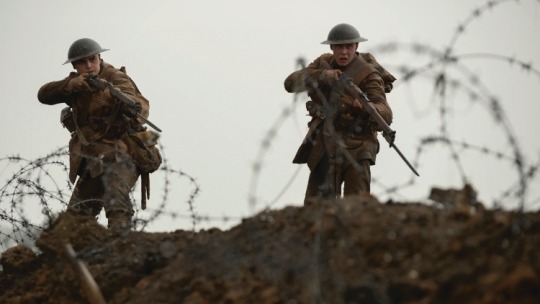
One of my favorite movies of the year is Sam Mendes’ absolutely brilliant World War I epic, following the journey of two soldiers, played by George MacKay and Dean-Charles Chapman, as they’re sent on a mission to the frontlines to deliver a message to hold off an attack on the Germans. I already reviewed the movie for ComingSoon.net, so I won’t say too much more about it, but it is a movie that works well on repeat viewings just because every aspect of the filmmaking is so masterful, particularly the decision to make the film a single shot. There’s a lot to talk about the technical aspects of the film from Roger Deakins’ cinematography to the breath-taking production design and gorgeous score by Thomas Newman, but I want to draw special attention to the screenplay by Mendes with Kristy
Wilson-Cairns, which I feel is being overlooked in favor of the technicality of the film, maybe since there are so many stretches without dialogue. Don’t let that fool you. It takes a great deal of research and description in a screenplay to lead to a movie this good, and the writing that forms the backbone of Mendes’ latest and greatest should not be ignored. 1917is easily one of the year’s best film, and though it only opens in New York and L.A. on Christmas Day, it will be nationwide on January 10.
KNIVES OUT (Lionsgate)
I also reviewed Rian Johnson’s comedic whodunnit right here, so I don’t have a ton more to say about it, but I’m so happy that it’s continued to do well since opening over Thanksgiving. If you haven’t seen it and want a fun couple hours at the movies, Johnson’s movie can provide that, but it’s also quite a brilliant twist on the ensemble whodunnit that I’ve generally been a fan of as a kid, and the movie definitely stands up to repeat viewings.
BOMBSHELL (Lionsgate)

I also highly recommend Jay Roach’s “workplace drama,” which is about the Fox News sex scandals, mainly surrounding the news corp’s founder Roger Ailes, as played by John Lithgow. The movie stars Charlize Theron as Megyn Kelly, Nicole Kidman as Gretchen Carlson and Margot Robbie as “Kayla Pospisil,” as a composite character, the story following the three FOX News employees as they navigate the difficult Venn Diagram of politics and sexuality (or sexualization). Most of the events take place around the 2016 Presidential Election and Donald Trump’s grilling by Kelly about his statements about women, something that backfires for the anchor. At the same time, Carlson is moved to an afternoon slot, and she decides to fight back against Aisles’ demotion (and her subsequent firing) by getting lawyers and accusing Aisles of sexual harassment. As we learn from Robbie’s character, Aisles gets up to much worse, and I loved what her character brought to the mix, particularly her relationship with Kate McKinnon’s character. I’m thinking the movie hasn’t gotten nearly as much traction with critics because it’s written and directed by men, in the former case, Charles Randolph, the Oscar-winning writer of The Big Short, but we have to give some credit to the amazing female cast assembled and what they were able to bring to the material to make the film far less dreary than it might have been despite the yucky nature of the Fox News world. I also think that attention should be paid to John Lithgow’s performance as Ailes, which is a lot more than a good make-up job. Lithgow is such a nice person so for him to play such an oily, slimy character so well makes me think he shouldn’t be overlooked in the awards conversation. This is now playing in about 1,500 theaters across the country, and hopefully, it will be in even more over the coming weeks.
LITTLE WOMEN (Sony)
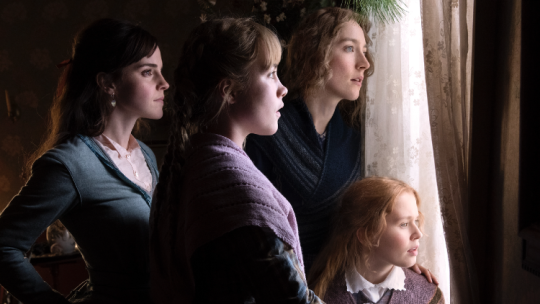
Sort of related to Bombshell in that it explores women’s issues from a very different standpoint, that of Louisa May Alcott’s classic piece of coming-of-age literature set post-Civil War. Greta Gerwig ably tackles far more difficult material for her second feature as a filmmaker, proving that Lady Bird was no fluke. It reunites Gerwig with that film’s Oscar-nominated star, Saoirse Ronan, playing Jo March, the writer who is trying to make her way in life and through her career as a writer. I’m not a huge fan of the source material but Gerwig and Ronan have created such a marvelous bundle of joy in this film that follows the journey of the four March girls, but does so in a non-linear way that forces to pay close attention. Ronan is wonderful, as always, but I was equally and maybe even more impressed by Florence Pugh, who plays the super-dramatic Amy in a way that makes her far more convincing as the younger and older versions of her character than some of the other young actresses. I think Emma Watson as Meg might be somewhat the weak link of the movie but she isn’t terrible and I did enjoy some of her scenes. Gerwig’s movie is rounded out by wonderful performances from the likes of Laura Dern, Timothée Chalamet (fantastic as Theodore Lawrence), Chris Cooper, Tracy Letts and others. Actually, I really loved all of the interactions between Chalamet, Ronan and Pugh, three fantastic actors who I’m sure we’ll continue to see more great things from over the next few decades. I haven’t seen enough of the adaptations of Alcott’s book to really know how this stands up, but it’s the first time I really was interested in these characters and their story, and that’s quite an achievement.
CLEMENCY (NEON)
Although Warner Bros’ JUST MERCY (see below) is getting a ton more attention and marketing, personally I preferred Chinonye Chukwu’s CLEMENCY (NEON), which premiered at Sundance way back in March but just had a much more lasting impact. It stars Alfre Woodard as a prison warden where the pressures of death row executions have started to take a toll on her personal life, especially with the impending execution of Aldis Hodge’s Death Row inmate, who claims his innocence. This is a really tough drama to watch at times, but with such amazing performances by Woodard and Hodge that it pulls you in and keeps you riveted to what might happen next. I’m a little bummed that Chukwu isn’t getting more attention for her brilliant work writing and directing the film vs. other films like the recent Queen and Slim. She’s a great filmmaker and I can’t wait to see her next film, A Taste of Power.
UNCUT GEMS (A24)
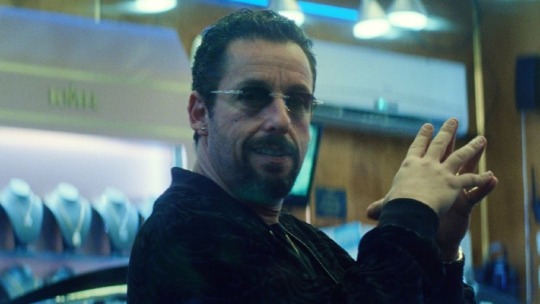
I’m not as big a fan of the works of Ben and Josh Safdie as many of my fellow critics are, but this crime-comedy (of sorts?) starring Adam Sandler, helped make me see their crazy mode of filmmaking in a new way. While I recommend this with reservations, I do think that Sandler’s role in the movie as Howard Ratner, a New York jeweler merchant to the stars, could help the Safdies break out to a new audience as they certainly seemed to have refined their mode of filmmaking with Uncut Gems, and the mix of characters and situations really make the movie something unlike anything else you’re likely to see this year. The gist of the story is that Howard gets his hands on a valuable gem from Africa and that seems to change his luck as a chronic gambler where everything seems to be going right for him… until it doesn’t. Much of the story involves him trying to get the rock back from basketball player evin Garnett (played by himself) who borrows the valuable gem and then won’t give it back. All-in-all, it’s a pretty entertaining film with an absolutely amazing last act that will expand nationwide on Christmas Day.
THE TWO POPES (Netflix)
In case you don’t want to go out in the cold this week, you can also stay home and watch some of the great films now on Netflix. While I assume you’ve already seen The Irishman and Marriage Story, I hope you’ll also check out this wonderful two-hander written by Anthony McCarten (Darkest Hour), which explores the relationship between Pope Benedict (Anthony Hopkins) and his successor Pope Francis (Jonathan Pryce), as they try to get along even though they don’t see eye-to-eye on how the Catholic Church should be won. I was a little surprised how much I enjoyed this movie, but it reminded of a little-seen 2016 movie called The Journey, a two-hander starring Timothy Spall and Colm Meaney as two sides of the war in Northern Ireland trying to come to an accord while driving to the airport from talks that have fallen apart. I’ve long been a fan of Pryce but playing the Argentine cardinal who would become Pope is a fantastic role that allows him to show so much more depth as an actor, but we also learn a lot about Pope Francis’ past and the regrets he has about his involvement with the government’s anti-religious actions. Hopkins is also great, and for a movie that’s mainly two men talking, it’s perfectly captivating.
Although it’s been out for a while now and has already been losing theaters, I also recommend checking out Marielle Heller’s It’s a Beautiful Day in the Neighborhood, starring Tom Hanks as Mr. Rogers, if it’s still playing anywhere near you, because it’s a really wonderful story about a journalist whose spotlight of Mr. Rogers turned into a way that he can find redemption in his own family issues.
I’ve actually seen a lot of the other movies opening in limited release this weekend, including the doc WHAT SHE SAID: THE ART OF PAULINE KAEL (Juno Films), which opens at New York’s Film Forum on Wednesday. If you’re even remotely interested in film criticism and its origins through the story of one of the most respected and beloved critics, you definitely should check this one out. I haven’t seen it since Doc-NYC back in 2018
As mentioned in my write-up of Clemency above, I wasn’t nearly as crazy about Destin Daniel Cretton’s JUST MERCY (Warner Bros.), which is a different movie with similar elements, this one starring Michael B. Jordon as Bryan Stevenson, a young civil rights attorney who is trying to free a wrongly-convicted Death Row inmate, played by Jamie Foxx. Cretton’s good luck charm Brie Larson (they first teamed for Short Term 12) is also in the movie, but I don’t feel she’s nearly as good, and there was just something about the movie that really didn’t click with me. Even so, it will also be nationwide on January 10 and maybe I’ll try to give it another chance before then.
I was semi-excited about Donnie Yen’s return in the title role of Wilson Yip’s grand finale, IP MAN 4: THE FINALE (Go USA Films), which has the martial arts master who trained Bruce Lee (and whose first name, I only just realized, is “Man”) comes to San Francisco in the late ‘60s to back up his pupil’s desire to teach non-Chinese martial arts. Along the way, he gets into issues with the local martial arts masters as well as the Marines, who believe that Japanese judo is the only proper martial art. As with some of the other movies in the series, this one is mainly good for Yen’s performance and his martial arts scenes, although Kwok-Kwan Chan is also excellent as Bruce Lee in one particularly good fight scene, and there are a few others as well. My main issue with this, as with may martial arts film from China, is that the American actors are written terribly and the performances they’re giving (particularly by regular offender Scott Adkns) are just terrible. It’s a classic case of over-villifying the non-Asian characters to the point of them being a joke, and there are few surprises about who is going to win in most fights. It’s been a while since I’ve seen the other chapters, and martial arts fans will probably like parts of this, but it’s not a particularly good movie when all is said and done.
A movie I liked quite a bit more is François Girard’s historical drama THE SONG OF NAMES (Sony Pictures Classics), produced by Robert Lantos (Barney’s Version), another terrific Canadian film that deals with Jewish issues. It stars Tim Roth as Martin Simmonds, a young British man whose family took in a Polish Jew named Dovidl, who was also a violin virtuoso, to live with them just before the start of WWII. The night of Dovidl’s anticipated 1951 live concert debut in London, he vanishes, and years later, Martin, starts to track down his old friend to find what happened to him. It’s a pretty amazing movie, partially due to Roth’s performance, but also the two young actors playing Martin and Dovidl, since so much happens in the past. Like much of Sony Classics’ output, this will probably appeal more towards older audiences, but it’s another original story set during the period of the Holocaust that puts its own spin on the times with the musical element, which plays such a large part in the film. (Clive Owen plays the older Dovidl, but it’s a fairly small role compared to the others.)
I’m very excited that The 21st Annual Animation Show of Shows (ACME Filmworks)is returning to the Quad Cinema on Christmas Day, and while I was hoping to write something more extended about this, I just haven’t had the time. There’s an amazing line-up of films from a lot of different countries including Germany, Switzerland, Russia, Belgium and more, but there’s also a couple doc shorts about the filmmakers among the films. The Czech Republic film Daughter was recently included on the Oscar shortlist for animated shorts, but otherwise, it’s a fairly strange mix of films, including the very disturbing Kids.
I haven’t seen Wayman Boone’s horror film Apparition (Vertical Entertainment), starring Mena Suvari and Kevin Pollak, but apparently, it’s another horror movie involving an APP that connects to the user to the dead. It’ll open this Friday.
A few other things on Netflix over the next couple weeks including John Mulaney and the Sack Lunch Bunch special, which looks like more quirky fun from one of my favorite stand-up comics. That opens on Christmas Eve i.e. today, while a couple new series begin on Netflix on New Year’s Day, The Messiah(starring the wonderful Michelle Monaghan) and Spinning Out.
I decided to take a much-needed break from the repertory stuff this week, but we’ll see what happens with that going into the New Year, and I’ll have my annual Top 25 to share with you all next week!
0 notes